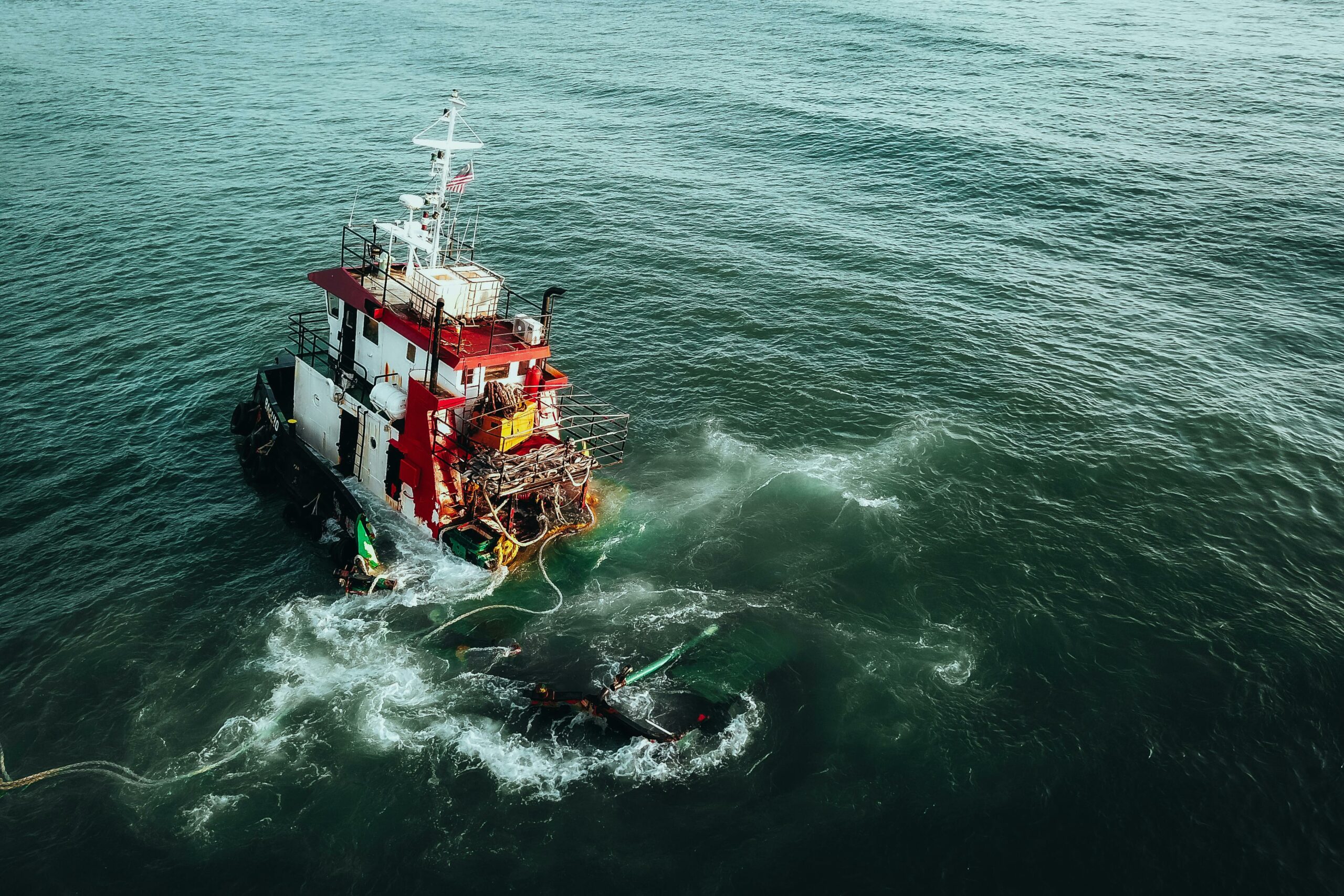A sermon on Matthew 14:22-33 for Kensington Community Church on the second Sunday in Lent. This sermon series is structured after the theme “Wandering Heart” from A Sanctified Art.
You will move in the direction of the thing you stare at…
A couple years ago, there was a loss in my family which brought all of us—my parents, my dozen siblings, and all their two hundreds kids, too—together. We were all packed into my oldest sister’s 3-bedroom house in small-town Michiana.
One day, towards the end of that trip, we were all in the street teaching my then-7-year-old nephew how to ride his bike, and it was a total lesson in collective impact.
My oldest brother convinced my nephew he could learn in a day and dared him to get started. One of my sisters provided motivation by promising a trip to the ice cream shop if he could ride all the way down the block.
We all took turns launching him—from getting him balanced and holding his bike, to walking along side as he started to pedal, then gently lifting our hands off the frame as he picked up speed, still hovering inches away to catch him before he fell. Another one of us would stand just a few feet ahead, walking backwards as he pedaled forward, encouraging him and basically giving him a destination to ride towards.
This began around noon, and by the time the sun was setting, my nephew could ride on his own for probably about a couple yards, before getting off his center and falling over. The ice cream was starting to seem further and further away.
When it was my turn to launch him, I noticed a pattern: he would get over-confident, lose focus on the auntie or uncle who he was riding towards, notice a parked car or a tree in the distance, suddenly start to panic about crashing, and lose his balance entirely.
So, I gave him a tip:
“Dude, your hands are going to steer the bike towards whatever it is you’re looking at. It’s like, automatic. If you’re looking straight forward at your auntie, you’re going to go straight forward to your auntie. But if you look at the cars and the trees, you’re going to go straight into them. When you start going sideways, point your head right back to auntie, and the bike will go there too—I promise.”
Lo and behold, it worked. It took some practice for him to start redirecting his focus where he needed it to go, but once he did, he kept his center and could ride in a straight line. First, a few more yards towards Auntie Gaby, then down the block, just far enough to get the ice cream that Auntie Hannah promised.
In this week’s passage
I think, in this week’s passage, we see Peter, and maybe the rest of the disciples, learn something like a spiritual version of that lesson—maybe not just you will move in the direction of the thing you are staring at, but you will move toward the spiritual reality you are staring at, you will find yourself moving towards the God you are looking towards… and you will find yourself wavering from the God you look away from. You will move in the direction of the thing you are staring at.
We start the passage with Jesus needing alone time and going up a mountain to pray. If this story starts to sound familiar, that’s because we just read another telling of it in the gospel of Mark.
Scholars generally believe that Mark’s version of the “Jesus walks on water” story was the first one going around in writing, and the part about Peter walking on water, too, was just a Palestinian oral tradition. And then eventually, for some reason—maybe because it taught an extra lesson that was missing before, maybe because they could suddenly afford the extra papyrus to write it on, I don’t know—the story about Peter gets canonized, added to the written tradition, too.
But anyways, Jesus goes to pray, and sends the disciples on ahead of him.
They go out on the water, and a wild storm comes. The disciples are overwhelmed, by the storm, meanwhile, Jesus decides that rather than sleeping on the mountain when he’s done praying, he’ll just walk across the water, as one does, to join his friends on the sea.
And during the fourth watch of the night—somewhere between 3 am and 6 am—the disciples see Jesus walking on water, approaching them.
All the disciples cry out: “a phantom!” “A ghost!”
They are experiencing something scary, and so they assume the next thing that happens must be scary, too.
But then Peter looks at that “ghost” and says… “Jesus!”
Maybe he wanted to test if the ghost is really Jesus, or maybe he sees Jesus in this miraculous state and starts thinking he can get away with that, too, I don’t know, but Peter asks Jesus to invite him out on the water, to walk with him.
Jesus says “come;” Jesus calls Peter to walk on water like Peter asked for. And Peter does it; he starts walking on water.
But then, Peter “sees the blowing wind”—a phrase which seems odd to me… it’s not like he didn’t see it before he called to Jesus, right? Like it’s not like he somehow mistakenly thought the seas were calm, did he?
But Peter sees the blowing wind, gets scared, and begins to sink.
When he does that, he cries out to Jesus, and Jesus saves him. Jesus asks Peter why he waivered, and everyone in the boat goes… wow. Truly he is God’s son.
Peter’s faith
This story is often told as one where Peter doesn’t have faith, but I think that’s not totally fair.
First of all, Jesus doesn’t say to Peter “oh you of no faith.” He says “oh you of little faith.” And transparently, like, compared to Jesus, don’t we all have little faith? The man was kind of a pro at the faith stuff.
No, Jesus asks Peter why he waivered—why he diverted from his faith—and that certainly does happen… more than once, even.
When the story starts, every other disciple is assuming that, because their current circumstances are scary, whatever comes next must be scary, too. Whatever comes next must be a ghost.
But Peter says “Jesus, call to me. Call me out with you.”
And when Jesus does, Peter doesn’t say “wait nevermind.” No, Peter walks on water. He does it. It works. Peter is getting the God he dares to believe in.
But then Peter sees the wind, he sees the cars off on the side of the road and fears his bike will crash into it, and he starts succumbing to the wind. He starts sinking.
But that’s not the end of his story; it’s not like his faith is totally shot. No, Peter returns, immediately, to faith in Jesus, this time not the luxurious faith of wanting something cool and neat, but a desperate faith, the faith you have when you believe because you need this to work.
Projecting on Peter
As we explore Peter’s wandering heart—his movement between faithful and wavering—we’re doing some intentional projection together. We’re looking for ways Peter’s faith journey might enlighten us about our own, might help us explore our own.
So to that end, I wonder: where are you in this story? Where are you personally, and where are you as in all of you, all of us… where is our church in this story?
Are you—are we—one of the disciples who’s in the middle of a crisis and assumes whatever comes next must also be a crisis, assumes that whatever we see must be a phantom and not Jesus calling to us?
Are we Peter, when says, “no, I think this really could be Jesus,” and asks Jesus to invite him onto the water? Do we believe in God’s goodness because we want to
Are we at the part of our story where we’re like Peter, who calls out to Jesus, sees Jesus offer a call back, and steps out in faith, believing that God really has called us to something big and trusting that it will all work out, even if we’re scared as scared can be?
Are we at the part of our story where we are like Peter just moments later, when he’s trusted Jesus, but starts to get distracted by scary winds and starts wondering if Jesus can really save him from all that—if the call Jesus has is really for him, too. If the God we believe in can really bring something good next.
Or are we, having been reminded of our greatest fears, now in a place where we believe in God’s goodness in a maybe deeper, maybe more meaningful way, because now we need to?
And… are we among the first transcribers of this story, who only remember the fantastic things we got to watch Jesus do apart from us, not the more complicated story of Jesus calling us to participate in his work, even when it doesn’t always have the tightest narrative? Or are we like Matthew, who said “no, the part about Peter joining in matters, too. The messy, sometimes-faithful-sometimes-not-so-faithful story matters, too.
The part where Jesus doesn’t just put on a show, but calls ordinary people to participate matters.
The part where those ordinary people kind of mess up a tiny bit, and they go from wanting Jesus to needing Jesus matters, too.
The story of the storm, and of the calm that is more meaningful because of what we did in the storm, is a story worth preserving, telling, celebrating, learning from. That story—that whole story—is a story worth being proud of.
Amen

